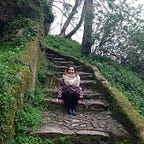For a weekend, I ‘occupied the future’
Last weekend I volunteered for Nesta, a global innovation foundation and an On Purpose placement host, at their flagship event, FutureFest. The annual 2 day conference aims to bring future thinking to the public realm, inviting its 4000 guests to ‘occupy alternative futures’. This year the event featured over 80 sessions, ranging from debates to performances, with a range of experts from the worlds of music, social enterprise, academia, politics and technology. Sessions followed three themes: Alternative Visions, Alternative You and Making Alternatives. Each explored bold new ways of thinking, being and doing, to solve the world’s biggest challenges. I particularly enjoyed the Alternative Visions theme, which explored practical alternatives for how society, economy, cities and democracies can operate. These sessions were impactful because the speakers didn’t just talk about ideas — they described their ongoing projects and their impact to date. Here are just three of my key takeaways:
Information and data provides power to the people.
As Bristol University professor Tom Sperlinger put it, the crises of the world will be crises of participation. With challenging times ahead and an ongoing crisis of global leadership, the idea that we need to put power back into the hands of the people really resonated with me. A few ideas about how to do this were discussed throughout FutureFest. The first was for schools and universities to educate students to critically assess the political system, to understand the modern-day implications of imperialism and to do practical problem solving for local communities as part of the curriculum. John Tolva, former Chief Technology Officer of Chicago, spoke about data as a public infrastructure and the need for ‘democracy by spreadsheet’, by making public data available to citizens, small businesses and social enterprises rather than only to large tech vendors and city governments. An example of a small organisation delivering public value as a result of an ‘open data city’ approach is the public transport app CityMapper, which sources live data from transit agencies.
Public spaces are worth creating and protecting.
A number of speakers, including Kate Raworth, author of Doughnut Economics, highlighted that community empowerment is not just about open data, but about opening up public spaces. Gabriella Gómez-Mont, the founder of Mexico City’s new experimental lab, stressed the city government’s role in creating physical places to build visibility and momentum for existing citizen-led economic and social development projects. She described how the Laboratorio para la Ciudad was able to carry out 80 collaborative urban experiments because it viewed its citizens not as 21 million mouths to feed but as 21 million minds to work with. Sandra Hoisz, Area Programme Manager at Groundwork London, described the power of green space in cities in bringing people together, allowing for a cross-pollination of ideas. Sandra recounted powerful testimonials from participants in community gardening projects, which expressed how their experience in these collective projects had given them confidence in their own ability to effect real change in their communities. Amy Lamé, London’s first Night Czar, made the case for ‘dark spaces’, such as bars, night clubs and restaurants, as important spaces for cultural networking. In case you’re not convinced, the ‘night-time economy’ also adds £26.3 billion to London’s economy — and £66 billion to the entire UK economy.
Technology is (not) the solution.
Many speakers stressed that technology can be problematic, particularly due to the human biases built into it and its ability to amplify the social problems of the real world, such as racism and fake news. However, an even stronger message came across: technology, if harnessed appropriately, is a powerful enabler to social change.
At the city level, the key to a successful smart city is to think about citizen needs first, and only then about how technology can support and empower citizens. A number of practical examples of this were discussed. MIT Professor Carlo Ratti outlined the Senseable City Lab’s research on the potential for autonomous sensing vehicles as solutions for air pollution, congestion and traffic accidents in large cities. Christelle Lahoud of UN Habitat described the Block by Block project, in which the game Minecraft is used as a participatory tool to help citizens develop ideas and gain funding to improve public spaces. Francesca Bria, Barcelona’s Chief Technology and Digital Innovation Officer, outlined how 70% of Barcelona’s action plan comes directly from citizens through a hybrid of online and offline democracy.
At the national level, Scotland’s First Minister Nicola Sturgeon outlined the massive opportunity for government to be an active participant in the ongoing tech revolution, capturing benefits for both the economy and society. She then announced a new fund, ShareLab Scotland, developed in partnership with Nesta, to support the development of collaborative digital platforms by social entrepreneurs to meet the needs of the most vulnerable communities in Scotland. This directly puts into practice the recommendation of Professors Kate Pickett and Richard Wilkinson to embed greater equality into institutions.
After immersing myself in exploring these bold visions, I left FutureFest with more optimism about the prospects for our collective future and more clarity about the roles government, social enterprise, technology and citizens can play in it. In particular, it renewed my interest in pursuing a career in citizen empowerment.
Nesta has posted videos of some FutureFest sessions. I would highly recommend checking them out, so you too can ‘occupy the future’. It is incredible.
